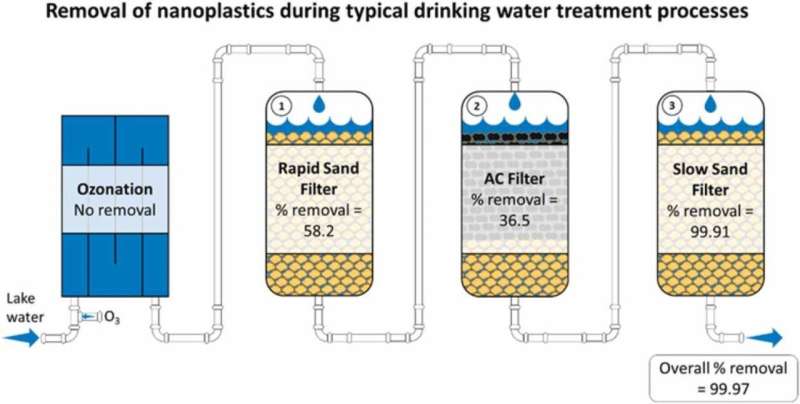Water treatment efficiently removes nanoplastics

It's a hot topic, at least on social media: tiny plastic particles allegedly end up not only in oceans and lakes, but also in drinking water—and, yes, even in bottled mineral water. Eawag and the Zurich Water Works launched a joint project in 2019 to find out whether the tiniest of particles, measuring less than a thousandth of a millimeter across, actually find their way from lake water into drinking water pipes and therefore into homes, hospitals and restaurants.
The results are now in, and they include some reassuring findings. In a report published today in the Journal of Hazardous Materials, the researchers show that even if untreated water contained considerable quantities of nanoplastics, these particles were retained in sand filters very efficiently during water treatment. Both in laboratory tests and in a larger test facility located directly on the premises of the Zurich Water Works, the biologically active slow sand filter was the most effective at retaining nanoparticles—achieving an efficacy level in the region of 99.9%.
So far, there has only been limited research into how exactly nanoplastics are formed. "But it would appear that the degradation of larger plastic particles in the environment eventually results in nanoplastics," says Ralf Kägi, Head of Eawag's Particle Laboratory. However, even the process of identifying nanoplastic particles is anything but easy. For this, the team of researchers from Eawag, ETH Zurich, EPFL and the Politecnico di Torino used labeled nanoplastic particles, whose route through—or final location in—the water treatment process could be tracked using a mass spectrometer. This process is similar to that used in medicine, where cancer cells are specifically labeled in order to monitor their potential distribution in the human body.
Modeling enables forecasts
The researchers took the experimental findings from small laboratory setups at Eawag and larger test facilities at the Zurich Water Works and combined them with complex theoretical model calculations. This allowed them to make predictions regarding the behavior of nanoplastics in drinking water treatment facilities. One interesting finding for water companies is that the models indicate a very high level of nanoplastic elimination even over long periods of time, such as when filters have a long operating life or long backwashing intervals.
More information: Gerardo Pulido-Reyes et al, Nanoplastics removal during drinking water treatment: Laboratory- and pilot-scale experiments and modeling, Journal of Hazardous Materials (2022). DOI: 10.1016/j.jhazmat.2022.129011




















